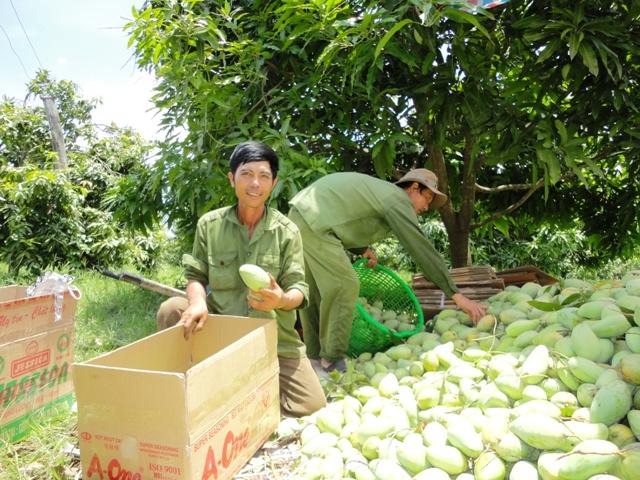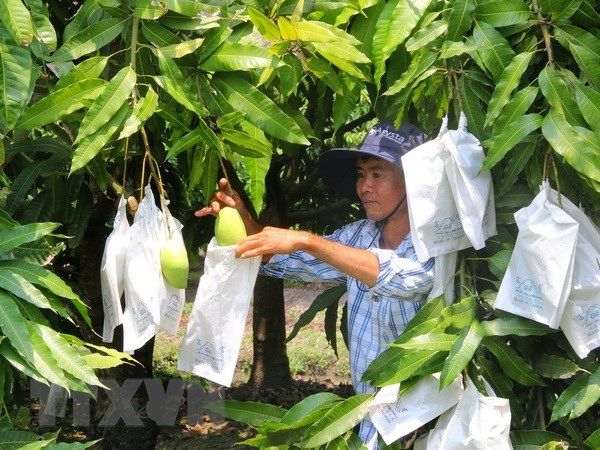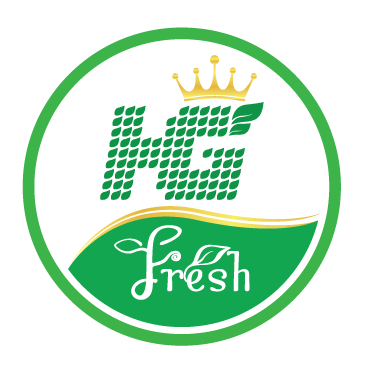In our country, mango is one of the main tropical fruits grown in Vietnam. The total area of mango growing in the country is about 87,000 hectares. In which, the Mekong River Delta accounts for 48%. More specifically, mango is one of the main export items of Vietnamese fruit and vegetables. Let's learn the model of growing clean mangoes - eligible for export!
Export market of Vietnamese mangoes
Vietnamese fresh mangoes are currently exported to 22 countries, mainly the Chinese market. Products from mango are exported to 53 countries.
In 2021, nearly 600,000 tons of mangoes will be exported to other countries, up 42% over the previous year. In which, export volume to Japan tripled from 215 tons in 2020 to 640 tons last year, similarly to Korea increased 130% of output,...

In terms of mango production, Vietnam is the fourth largest country in ASEAN, after Thailand, Indonesia and the Philippines. Vietnam has joined the world mango market but with limited quantity.
Mangoes are grown all over the country. But mainly concentrated in the Southern region with different varieties. The current dominant varieties are: Hoa Loc sand mango, Cat Chu mango, Buoi mango, Canh Nong mango, Thai mango, Tu Quy mango, Taiwanese mango, etc.
To improve economic efficiency from mango trees. Mango growers need to have solutions to manage, purchase, and sell products, etc. In particular, focus more on planting and caring techniques to prevent pests and diseases, produce safe fruits, reach high quality.
The process of implementing the model of growing clean mangoes - meeting export standards
Let's explore the following
1.Growing technique
First of all, about planting techniques, we must consider the following things:
1.1 Choosing an area or garden to grow mango
Must ensure drainage in the rainy season, prevent erosion to keep soil fertility.
Must choose a well-ventilated garden, limiting harmful pests and diseases; ...
The width and depth of the drainage ditch must be arranged in accordance with the terrain of the land you choose. Auxiliary ditch 0.3-0.4m wide, 0.3-0.4m deep; main ditch is 0.5-0.8m wide, 0.5-0.7m deep.
Choose the right plants to plant as windbreaks around the garden such as: vase, black eucalyptus, eucalyptus, etc.
In the first years of growing mango, it is possible to intercrop short-term crops such as beans, corn, etc.

Selecting seedlings to plant
Select trees propagated by clonal methods, grafted trees to quickly produce fruitand preserve the quality of the mother plant.
The height is about 60-80cm, starting from the compound eye upwards. Body diameter 0.8-1.2cm.
Trees are uniform, correct varieties, straight stems, healthy growth , no pests and diseases.
Mango planting hole
Dimensions 60x60x50cm. Each support takes the topsoil and mixes it with 20-30kg of organic fertilizers: manure, decaying garbage; 0.5-1kg lime powder; 0.5-1kg phosphorus. Then put this whole mixture in the hole, let it sit for 20-30 days before planting.
Mango planting distance
Should be planted with a distance: 7x7m, 8x7m, 8x8m or 8x9m. If the stem is tall: 5x6m, 6x6m. The canopy must be created regularly if the density is thicker.
How to grow mango
Before planting, tear off the plastic bag and place the plant in the center of the hole, gently spread the soil around the potting soil and gently press the soil around the pot with your hands.
In lowland, floating planting to create an environment for the roots to develop. Then use stakes 0.7-1.0m diagonally through the main body and use a soft rope to tie the tree firmly to the stake to avoid high winds causing the root to grow.
Use straw, rotted garbage and water to keep the plant moist continuously for a month.
2.Mango care techniques
Fertilization
Basic construction stage: annual fertilizer 100-150g/root/time NPK 20:20:15+TE. In the first year, you should mix fertilizer with water to irrigate every 2 months.
Business stage: Need to fertilize mango trees fully. The phenomenon of inter-yearly mango trees was determined to be due to inadequate fertilization and care.
Principle of fertilization: In the year of harvest and after harvest, the amount of fertilizer must be increased so that the tree has enough power to raise fruit in the following year. Plants with many leaves on good, fertile soil do not fertilize a lot of nitrogen. Depending on the variety of mango, if you apply a lot of urea and potassium, it is easy to lead to fruit cracking or acrid fruit. We note to limit or should add lime or spray foliar fertilizers containing calcium (CaCl2, Ca(NO3)2, ...).
Amount of annual fertilizer: 50kg/plant decayed organic fertilizer; phosphorus 1.5- 2.5kg/plant; lime 1.0-2.0kg/tree; urea 1.5-2.0kg/tree; potassium 0.8-1.6kg/plant; lime 1.0-2.0kg/tree.
Time of application: 1 month before flowering time; 3 weeks after fruit set, fertilize at 8-10 weeks after fruit set and after harvest.
Sprinklers
Water year round when the plant is young to provide enough water for the buds to form and develop. In the dry season, it is recommended to water periodically every 3-5 days. and must be watered regularly after harvest to maintain soil moisture 50–60%.
2 months before flowering, mango needs a dry period to differentiate flower buds. After flowering and during the fruit bearing period, water continuously!
Weeding
Clean grass close to the root 3-4 times/year. Spreading grass blades between rows to form beds has the effect of preventing soil erosion in the rainy season and preventing fire in the dry season.
Pruning branches to create canopy
When the tree has 4–5 layers of leaves, 0.8–1.0 m high, when young, press the buds to produce level 1 branches, pruned to leave 3 buds growing in 3 equal directions. When level 1 branches are 0.5–0.8m long, continue pruning and leave only 3 branches. From level 2 branches, leave 3 branches. Then stop pruning to let the tree grow naturally, this time the tree will have a solid frame, the canopy will grow in a round shape later.
Every year, it is necessary to prune branches, at least twice a year, the first time after harvest and the second time before flowering.
Flowering treatment
Irrigation chemicals allowed to be used in Vietnam for flower treatment such as Paclobutrazole at the root when the mango leaves are young, watering 0.5-1.0m away from the base of the tree. Then, water continuously 1-2 days / time for 7 days.
After 25-30 days when treating Paclobutrazole, apply fertilizer for the second time, can combine spray MKP 0:52:34 with a dosage of 50-80g/10 liters of water, spray once every 10 days, spray 2-3 times.
After 45-60 days when treating Paclobutrazole, spray KNO3 to stimulate flowering. Spray when the weather is dry, the shoots are strong, protruding, the veins develop or curl. After 5-7 days, spray again for a second time, with a 50% reduction in dosage.
Increase fruit set
When inflorescence is 10-12 cm long, spray insecticides in combination with foliar fertilizers with high Bo content to enhance fruit setting. In the fruit development stage, fertilize enough and water enough to help the plant absorb nutrients well. Periodic pest control to maintain yield and fruit quality.
Fruit bag
Use specialized materials to limit pests and diseases and ensure the sensory quality of the fruit. Before fruit packing, spray pesticides to prevent pests and diseases in combination with fruit pruning. Cover the fruit when the fruit has passed the physiological shedding stage of 40-50 days of age.
3.Prevention of pests and diseases
Mango leafhopper
Pruning branches, cleaning the garden after harvest. Using a light trap, place a basin of soapy water mixed with soap and oil under the trap one to two weeks before the flowering stage to attract larvae. This method is only effective when the hoppers have not laid eggs and applied on a moonless night.
At the stage of mango flower bud, detected the presence of aphids sprayed with biological active ingredients Matrine, Abamectin, Emamectin benzoate, Azadirachtin, Rotenone,...
Worms eat mango flowers
When the plants begin to bloom, the density of pests is still low (5% of cotton is damaged), use drugs with active ingredients Matrine, Rotenone, Permethrin to spray in the afternoon.
Body cut hair cut
Worms destroy all year round, so it is necessary to clean the garden well and detect it early. Prune and destroy damaged branches to kill pests and pupae. Visit the garden regularly to detect borer holes (use wire to poke holes in the hole to kill worms, pay attention around tree stumps and large grasslands).
Arrange
Using water to irrigate plants can limit the density of thrips. At the stage of mango shoots and leaves, if the density of thrips is high, spray with active ingredients Abamectin, Azadirachtin,...
Mealybugs
Destroy the parts with aphids, aphids, kill ant species symbiotic with aphids. When the density of aphids is high, spray with active ingredients Dimethoate, Imidacloprid,...
Mango top borer
Newly damaged shoots are detected, cut off and destroyed immediately to kill worms. Burn the dead leaves and branches to kill the pupae.
Ivory beetles chisel tops
Cut off damaged shoots and destroy them to kill larvae and pupae. During the period when the mango tree has a lot of buds or detects young worms, drugs with active ingredients such as Abamectin, Chlorpyrifos Ethyl can be used, etc.
Fruit fly
Cover the fruit to prevent yellow flies from damaging and laying eggs on the fruit. Use pheromone traps or hydrolyzed protein baits to kill yellow flies. Spraying SOFRI protein baits in the garden to prevent yellow flies.
Anthracnose disease
Destroy infected branches and leaves to avoid spreading. Prune branches to create canopy in time, fertilize balance according to each growth stage of the tree. When the disease appears, spray with active ingredients Propineb, Copper Hydroxide, ...
Bacterial spot disease, fruit rot
Destroy infected leaves and fruit to avoid spreading. Use specific drugs on the list of drugs permitted for use with registration on mangoes or drugs with chitosan ingredients to prevent diseases.
Frog skin spot disease
Destroy infected fruit to avoid spreading. Prune branches to create canopy in time, fertilize balance according to each growth stage of the tree, clean the garden regularly. In gardens where diseases often occur, spray after the physiological stage of fruit drop (30-35 days after flowering) with drugs: Benlate 50 WP, Derosal 60 WP, or Chlorine 0.04% or vice versa. This disease can also be prevented.
Powdery mildew disease
Prune leaves to create ventilation in the garden. Collect and destroy diseased parts. Timely spraying pesticides to protect flowers and young fruit. Can use drugs with active ingredient Diniconazole (min 94%), active ingredient Hexaconazole (min 85%) or active ingredient Sulfur.
Harvest
Mangoes reach maturity about 90-120 days after fruiting. Depending on the type of fruit, but if the skin is smooth, the skin is thick , the fruit sinks when dropped in water or the density is 1.02, it can be harvested.
Should be harvested when it is cool, do not harvest after rain or a lot of fog.
When picking fruit, it is recommended to leave the stalk 5-10cm so that the latex does not flow to the fruit, keep the fruit in good shape and reduce the rate of damage during storage or transportation.
Do not let the fruit come into direct contact with the soil, avoid overlapping and have the stem intact, turn the head upside down to dry the plastic before the paper bag is put into the box.
Processing and preserving
Sort fruit by 3 weight sizes: Type 1: 401-450g; type 2: 351-400g and type 3: 300-350g, depending on the requirements of the consuming market.
Fruits after sorting are treated with hot water at 520C with 200ppm Choline Chloride for 2-3 minutes. Soaking in warm water loosens the wax film on the surface of the fruit and cleans the pus on the peel. Treat with a solution of preservative AC-36 FDA diluted with water in a ratio of 1:1.
Dry the fruit after dipping in the storage solution at room temperature for 2 hours. During the time when the fruit is not completely dry, do not contact the fruit skin to avoid puncturing the wax film.
Packed in cartons with ventilation holes, no more than 4 layers of fruit/carton and stored at room temperature (the storage room must be clean and cool).
The above is a clean mango growing model - qualified for export and capable of competing with current mass-produced products. Especially high yield, increase fruit quality brings high economic efficiency to producers. Hope this article provides useful information for all of you!
